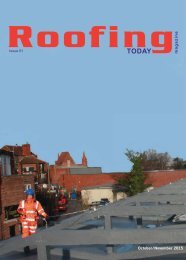Roofing
Roofing%20Today%20Issue%2065%20July%202016
Roofing%20Today%20Issue%2065%20July%202016
You also want an ePaper? Increase the reach of your titles
YUMPU automatically turns print PDFs into web optimized ePapers that Google loves.
Standards<br />
Raising the Roof on Ladder Safety<br />
Roof ladders remain one of the major work at height categories with no British standard.<br />
Paul Bruton, WernerCo’s Product Development Director, assesses the shortcomings of the current standards and the<br />
impact that the introduction of a new British Standard for roof ladders will have on the industry.<br />
t<br />
According to Health and Safety Executive (HSE) statistics,<br />
roofers account for nearly 24% of all work at height fatalities - and<br />
falls from height are the biggest cause of worker deaths across<br />
the entire construction industry.<br />
Despite the substantial risk posed to workers, the use of roof<br />
ladders remains one of the major ladder categories where no<br />
British standard exists. Thankfully, this is going to change as the<br />
British Standards Institution (BSI) is bringing about the<br />
development of an industry standard.<br />
That such a standard is needed, is borne out by the way ladder<br />
users are seen trying to comply with regulations and mitigate<br />
risk. Work at Height regulations state that special measures must<br />
be taken (the use of an access platform or scaffolding) where it is<br />
not possible to maintain a constant handhold on a ladder; a<br />
stipulation that has led to an increase in the use of personal fall<br />
protection equipment (PPE) when using roof ladders. This<br />
addition of extra safeguards for workers highlights the concerns<br />
with current roof ladder guidance.<br />
Graham Arundell, Managing Director of the Hire Association<br />
Europe (HAE) agrees: “The fact that workers using roof ladders<br />
are taking these extra precautions highlights that there may need<br />
to be a change in design to meet new criteria and ensure workers<br />
are safe when at height.”<br />
“The introduction of the new roof ladder British Standard is a<br />
significant move forward for the industry and one that is long<br />
overdue. Roof ladders are arguably the most high-risk ladder<br />
category, yet are the only one that has no British or European<br />
standard.”<br />
Of course, current HSE guidelines already set out some requirements for<br />
roof ladders. The HSE states that roof ladders must be designed for the<br />
purpose, of good construction, properly supported, and, if used on a<br />
sloping roof, they must be securely fixed by means of a ridge hook placed<br />
over the ridge bearing on the opposite roof. It also states that ladders<br />
should be used in addition to eaves-level edge protection, and gutters<br />
should not be used to support any ladder.<br />
Critical Issues<br />
But, as Peter Bennett at PASMA explains, some critical issues remain:<br />
“Currently there are no product design standards setting minimum<br />
strength or dimensional requirements for roof ladders.<br />
“In the absence of such a standard, designers and manufacturers have<br />
been left without guidance on critical issues such as: the strength<br />
requirements for the hook arrangement at the top of the ladder, the<br />
maximum deflection allowed in the ladder under load, the clear distance<br />
below the ladder to provide a safe foothold when climbing. All of these<br />
safety critical factors, together with specific markings and user<br />
information, will be considered in the standard.”<br />
Peter continues: “Current designs will need to verify the strength of the<br />
hook arrangement at the top of a roof ladder to take into account the roof<br />
angles which the standard will consider. The stiffness of some current<br />
ladder designs may also be challenged together with the form and<br />
dimensions for bearers - the parts which rest on the surface of the roof<br />
underneath the ladder.”<br />
There is understandably some confusion relating to when a roof ladder<br />
should be used and when alternative access equipment is<br />
t<br />
Enquiry 18<br />
Page 28 <strong>Roofing</strong> Today




